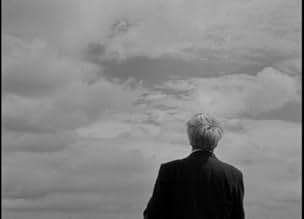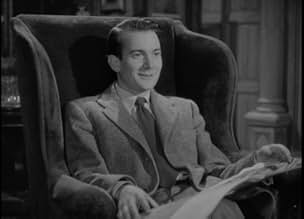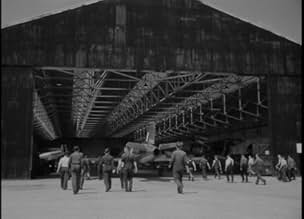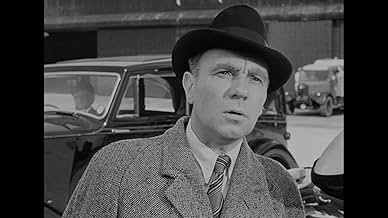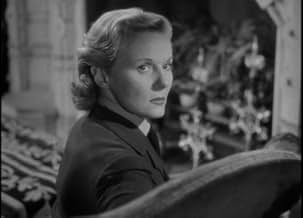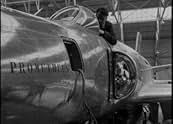AVALIAÇÃO DA IMDb
6,7/10
2,5 mil
SUA AVALIAÇÃO
Adicionar um enredo no seu idiomaFictionalized story of British aerospace engineers solving the problem of supersonic flight.Fictionalized story of British aerospace engineers solving the problem of supersonic flight.Fictionalized story of British aerospace engineers solving the problem of supersonic flight.
- Ganhou 1 Oscar
- 9 vitórias e 5 indicações no total
Rodney Goodall
- Little Boy
- (não creditado)
Donald Harron
- ATA Officer
- (não creditado)
Vincent Holman
- Factor
- (não creditado)
Jolyon Jackley
- Susan's Baby
- (não creditado)
Douglas Muir
- Controller
- (não creditado)
Leslie Phillips
- Controller
- (não creditado)
Anthony Snell
- Peter Makepeace
- (não creditado)
Sally-Jane Spencer
- Daughter of Philip
- (não creditado)
Robert Brooks Turner
- Test Bed Operator
- (não creditado)
Avaliações em destaque
I first watched THE SOUND BARRIER on TV in 1975, and liked it immensely, finding it both informative and intelligent in its presentation- It keeps the viewer interested to the end, no doubt because David Lean's direction is very good, at times even inspired, and it is helped by extremely competent cinematography and a credible screenplay.
Sir Ralph Richardson is superb as JR, a man obsessed with building ever better aircraft in competition with de Havilland and other companies, to the point of driving his son (well played by Denholm Eliott) and his son in law (Nigel Patrick) to their deaths.
I also liked John Justin as the pilot who finally breaks the sound barrier.
Ann Todd, who was married to David Lean at the time, somehow does not seem right for the part. I would have liked to see Vivien Leigh or Kay Walsh in that part, as both conveyed their emotions more readily and in greater depth.
The technical aspects are succintly but clearly presented, and the discussion about the telescope and how what you see there is from 700,000 light years, and more, ago, certainly makes me realize my insignificance, every time I see THE SOUND BARRIER.
David Lean had just come from making three masterpieces. BRIEF ENCOUNTER, GREAT EXPECTATIONS and OLIVER TWIST, and this is a transitional film, which already carries some signs of the epic that would emerge with the superlative THE BRIDGE ON THE RIVER KWAI, and be continued with LAWRENCE OF ARABIA, DR ZHIVAGO, RYAN'S DAUGHTER and, just before his death, PASSAGE TO INDIA.
Recommended. 7/10
This black and white early 50s movie shows crusty Britain at its stiff upper lip best. It is the story of mans obsession with speed, and a ruthless plane makers ambition to succeed in building a supersonic jet. Richardson plays the tycoon whose dream kills his son and son-in-law, but who finally sees the error of his ways and whose daughter returns to the cold family home with his grandson.
The film is also a vehicle to show the world Britain's proud lead in jet technology. There is a classic sequence in the film where the happy daughter and son-in-law deliver a De Havilland Vampire jet fighter to Egypt. They set off at breakfast time in England and hurtle over the English Channel, the Alps, Ancient Greece and the Pyramids before arriving in at the airfield. Of course we take this for granted now, but 47 years ago this was unheard of. The director contrasts the old ruins and remains of our ancient ancestors with the marvel of the modern age: the jet plane.
The film also introduced THE marvel of the early fifties, the De Havilland Comet jet liner. This beautiful but flawed machine was in service SIX years before any other jet liner and for a while, the world rushed to De Havillands, and Britains door. For two years the worldwide fleet gave the travelling of the future.
In every other way this is an eccentrically English film with creaky old houses, cottages with roses around the door and eccentric engineers. Shout in glorious black and white it conveys a sense of wonder and optimism in the future, whilst being thoroughly old fashioned
The film is also a vehicle to show the world Britain's proud lead in jet technology. There is a classic sequence in the film where the happy daughter and son-in-law deliver a De Havilland Vampire jet fighter to Egypt. They set off at breakfast time in England and hurtle over the English Channel, the Alps, Ancient Greece and the Pyramids before arriving in at the airfield. Of course we take this for granted now, but 47 years ago this was unheard of. The director contrasts the old ruins and remains of our ancient ancestors with the marvel of the modern age: the jet plane.
The film also introduced THE marvel of the early fifties, the De Havilland Comet jet liner. This beautiful but flawed machine was in service SIX years before any other jet liner and for a while, the world rushed to De Havillands, and Britains door. For two years the worldwide fleet gave the travelling of the future.
In every other way this is an eccentrically English film with creaky old houses, cottages with roses around the door and eccentric engineers. Shout in glorious black and white it conveys a sense of wonder and optimism in the future, whilst being thoroughly old fashioned
A young RAF pilot test's his father-in-law's prototype supersonic aircraft to the limit, at a time of intense development activity in the field of aviation, just as commercial jet airliners are about to come into service.
This is one of David Lean's less well-known films, in which some of the development milestones and incidents in contemporary UK aviation were put into a dramatic context. It should be mentioned that the aero industry was probably the UK's largest single industry by the end of WWII; it is thought that approximately 25% of the entire UK economy was devoted to aircraft manufacturing and allied industries; for four long years air power had been Britain's main means of striking back at Germany. Although activities were somewhat reduced in peacetime, the UK lead the way in several key aviation fields in the late 1940s and early 1950s; there was a new Cold War to be fought.
Now, lot of reviews here assume that the events portrayed were completely fictional (a la U571); whilst no film is beyond reproach in this respect in point of fact in this case nothing could be further from the truth; this film used no fewer than eight of the UK's most experienced test pilots as consultants. One of the eight, John Derry, reached supersonic speeds on 9th september 1948, whilst in a shallow dive in the third DH108 prototype.
The phenomenon of 'control reversal' at transonic speeds can and does occur with some wing designs; essentially at very high speeds the angle of attack of the wing is dramatically altered (because the control surface loads twist the wing essentially) and thus the intended effect of the controls can be reversed. This phenomenon is known to have afflicted aircraft such as early marks of spitfire, and this could limit the safe speed in a dive until a (torsionally stiffer) revised wing was introduced. It is just one of the many things that can occur in or near the transonic regime, and was probably chosen for the film because it is both simple and dramatic, and by then fairly well-known.
Flying military jet aircraft at that time was incredibly dangerous even without being shot at; peacetime training accidents were numerous. On some types an aircraft would be lost for every 1000 hours flying time and in a little under half of those losses the pilot was killed too. Test pilots had it worse than that; one of the eight test pilots who was consultant on this film was credited posthumously; he passed away between when the film was shot and released. Indeed the film refers to the loss of Geoffrey de Havilland (which in reality occured in 1946) again in a DH108 prototype. It is sobering to note that there are no surviving DH108 prototypes because they were all lost in (fatal) crashes.
In this film the human drama is played well enough with fine ating and good production values, but all this definitely takes second place to the aircraft and the flying. We see (apparently) a wartime spitfire in a high speed dive, Supermarine Attacker WA485, De Havilland Comet G-ALYR, a De Havilland Vampire and a Supermarine Swift.
In one magical sequence they have breakfast in the UK, fly to Cairo for lunch whilst delivering an aircraft, and then cadge a ride home on a Comet undergoing evaluation testing for BOAC. All at high altitude, high speed, jet-smooth, way above the clouds; something airline passengers of the time could only imagine until the Comet entered service during 1952.
Comet G-ALYR (one of the first batch of production Comet Mk 1 aircraft) was badly damaged in a taxi-ing accident a year or so after this film was made. Nonetheless it had already flown about 750 times and the fuselage was eventually used for water-tank fatigue testing, the lessons of which were learned from world-wide and are still relevant to this day.
This film isn't technically perfect but it is by no means as flawed as others would have you believe. It is stronger as a film about flying than a drama, but it is by no means bad in either respect. It gets a solid 8/10 from me.
This is one of David Lean's less well-known films, in which some of the development milestones and incidents in contemporary UK aviation were put into a dramatic context. It should be mentioned that the aero industry was probably the UK's largest single industry by the end of WWII; it is thought that approximately 25% of the entire UK economy was devoted to aircraft manufacturing and allied industries; for four long years air power had been Britain's main means of striking back at Germany. Although activities were somewhat reduced in peacetime, the UK lead the way in several key aviation fields in the late 1940s and early 1950s; there was a new Cold War to be fought.
Now, lot of reviews here assume that the events portrayed were completely fictional (a la U571); whilst no film is beyond reproach in this respect in point of fact in this case nothing could be further from the truth; this film used no fewer than eight of the UK's most experienced test pilots as consultants. One of the eight, John Derry, reached supersonic speeds on 9th september 1948, whilst in a shallow dive in the third DH108 prototype.
The phenomenon of 'control reversal' at transonic speeds can and does occur with some wing designs; essentially at very high speeds the angle of attack of the wing is dramatically altered (because the control surface loads twist the wing essentially) and thus the intended effect of the controls can be reversed. This phenomenon is known to have afflicted aircraft such as early marks of spitfire, and this could limit the safe speed in a dive until a (torsionally stiffer) revised wing was introduced. It is just one of the many things that can occur in or near the transonic regime, and was probably chosen for the film because it is both simple and dramatic, and by then fairly well-known.
Flying military jet aircraft at that time was incredibly dangerous even without being shot at; peacetime training accidents were numerous. On some types an aircraft would be lost for every 1000 hours flying time and in a little under half of those losses the pilot was killed too. Test pilots had it worse than that; one of the eight test pilots who was consultant on this film was credited posthumously; he passed away between when the film was shot and released. Indeed the film refers to the loss of Geoffrey de Havilland (which in reality occured in 1946) again in a DH108 prototype. It is sobering to note that there are no surviving DH108 prototypes because they were all lost in (fatal) crashes.
In this film the human drama is played well enough with fine ating and good production values, but all this definitely takes second place to the aircraft and the flying. We see (apparently) a wartime spitfire in a high speed dive, Supermarine Attacker WA485, De Havilland Comet G-ALYR, a De Havilland Vampire and a Supermarine Swift.
In one magical sequence they have breakfast in the UK, fly to Cairo for lunch whilst delivering an aircraft, and then cadge a ride home on a Comet undergoing evaluation testing for BOAC. All at high altitude, high speed, jet-smooth, way above the clouds; something airline passengers of the time could only imagine until the Comet entered service during 1952.
Comet G-ALYR (one of the first batch of production Comet Mk 1 aircraft) was badly damaged in a taxi-ing accident a year or so after this film was made. Nonetheless it had already flown about 750 times and the fuselage was eventually used for water-tank fatigue testing, the lessons of which were learned from world-wide and are still relevant to this day.
This film isn't technically perfect but it is by no means as flawed as others would have you believe. It is stronger as a film about flying than a drama, but it is by no means bad in either respect. It gets a solid 8/10 from me.
This mid-period David Lean picture is one of his most unusual a drama woven out of a story of scientific exploration. Not an easy kind of picture to make, but one held together by Lean's refined direction, a great cast and a surprisingly good script by Terence Rattigan.
Although Lean was to make two small-scale pictures between this and Bridge on the River Kwai, this is perhaps more than any other a transition film between his early intimate dramas and the later massive epics he is now best known for. From the start Lean had always tried to photograph the psychological states of his characters, but The Sound Barrier is the first time he tells a bigger story through the personal experiences of individuals. This is the formula that has made Kwai and Lawrence of Arabia so popular and enduring. Like those later pictures, in the Sound Barrier the narrative switches to carry on the story through the eyes of other characters.
A story like this, concerning test pilots, engineering and scientific breakthroughs, will only work if there is a strong drama underlying it otherwise it's only going to be of interest to techies. Lean seems totally aware of this and emphasises the human story behind the science. He directs with his editor's eye, composing action sequences with series of still shots, then throwing in the occasional sharp camera move to punctuate an emotional moment. He is moving away a little from the rather obvious expressionistic techniques of his earliest films towards a more straightforward yet effective style.
By the early 50s the golden age of British film was over, but there was still a good crop of acting talent on offer, and there are plenty of names to mention in The Sound Barrier. Ralph Richardson plays (as he often did) the overbearing father-in-law, and lends the film a touch of class. Ann Todd, who was Lean's wife and not an exceptional actress, here gives what is probably her best performance she has the most difficult part in terms of emoting, but she carries it off brilliantly. This is also a great before-they-were-famous film, featuring a young Denholm Elliott (best known as Marcus Brody from the Indiana Jones films) and Leslie Phillips in his pre-Ding Dong days. The real acting treat here though is the rarely-seen John Justin, who failed to achieve stardom not through lack of talent, but through lack of interest on his part. His poignant final scene is one of the strongest in the whole picture.
Of course, it's not just the plot of The Sound Barrier that is a work of fiction the science is complete nonsense as well, so don't go thinking that pilots really reverse their controls to get through the sound barrier. In many ways, this film reminds me of Dive Bomber, made ten years earlier with Errol Flynn and Fred MacMurray. That's also a test pilot drama, with a fair few plot similarities. One major difference though is that whereas Dive Bomber deliberately and bluntly disposes of any romantic angle, writing the female characters out of the story halfway through, in The Sound Barrier it is the pressures on the wives and sisters that is pushed to the fore. Ultimately, it is the way The Sound Barrier deals with loss and guilt that make it a strong and satisfying film.
Although Lean was to make two small-scale pictures between this and Bridge on the River Kwai, this is perhaps more than any other a transition film between his early intimate dramas and the later massive epics he is now best known for. From the start Lean had always tried to photograph the psychological states of his characters, but The Sound Barrier is the first time he tells a bigger story through the personal experiences of individuals. This is the formula that has made Kwai and Lawrence of Arabia so popular and enduring. Like those later pictures, in the Sound Barrier the narrative switches to carry on the story through the eyes of other characters.
A story like this, concerning test pilots, engineering and scientific breakthroughs, will only work if there is a strong drama underlying it otherwise it's only going to be of interest to techies. Lean seems totally aware of this and emphasises the human story behind the science. He directs with his editor's eye, composing action sequences with series of still shots, then throwing in the occasional sharp camera move to punctuate an emotional moment. He is moving away a little from the rather obvious expressionistic techniques of his earliest films towards a more straightforward yet effective style.
By the early 50s the golden age of British film was over, but there was still a good crop of acting talent on offer, and there are plenty of names to mention in The Sound Barrier. Ralph Richardson plays (as he often did) the overbearing father-in-law, and lends the film a touch of class. Ann Todd, who was Lean's wife and not an exceptional actress, here gives what is probably her best performance she has the most difficult part in terms of emoting, but she carries it off brilliantly. This is also a great before-they-were-famous film, featuring a young Denholm Elliott (best known as Marcus Brody from the Indiana Jones films) and Leslie Phillips in his pre-Ding Dong days. The real acting treat here though is the rarely-seen John Justin, who failed to achieve stardom not through lack of talent, but through lack of interest on his part. His poignant final scene is one of the strongest in the whole picture.
Of course, it's not just the plot of The Sound Barrier that is a work of fiction the science is complete nonsense as well, so don't go thinking that pilots really reverse their controls to get through the sound barrier. In many ways, this film reminds me of Dive Bomber, made ten years earlier with Errol Flynn and Fred MacMurray. That's also a test pilot drama, with a fair few plot similarities. One major difference though is that whereas Dive Bomber deliberately and bluntly disposes of any romantic angle, writing the female characters out of the story halfway through, in The Sound Barrier it is the pressures on the wives and sisters that is pushed to the fore. Ultimately, it is the way The Sound Barrier deals with loss and guilt that make it a strong and satisfying film.
The opening of the film, when a World War II fighter pilot hit what used to be called "compressibility," was a suspenseful interlude for the audience, particularly since it wasn't explained at the time.
The film was shot in monochrome, and was produced during a time that technology was accelerating, and this was one of the early films outside some of the science-fiction films of the era that was pro-technology. It is interesting that most of the major characters were obsessed with pushing the envelope.
As has been mentioned elsewhere, the "solution" presented to maintaining control of a supersonic aircraft actually is inaccurate. When a reporter asked the person who first actually broke the sound barrier, Gen. Chuck Yaeger, about that "solution," he indicated that doing what was proposed would have ensured the death of the pilot.
The film is well worth watching, if for no other reason than to get a taste of people taking baby steps in the new world of postwar technology.
The film was shot in monochrome, and was produced during a time that technology was accelerating, and this was one of the early films outside some of the science-fiction films of the era that was pro-technology. It is interesting that most of the major characters were obsessed with pushing the envelope.
As has been mentioned elsewhere, the "solution" presented to maintaining control of a supersonic aircraft actually is inaccurate. When a reporter asked the person who first actually broke the sound barrier, Gen. Chuck Yaeger, about that "solution," he indicated that doing what was proposed would have ensured the death of the pilot.
The film is well worth watching, if for no other reason than to get a taste of people taking baby steps in the new world of postwar technology.
Você sabia?
- CuriosidadesThe flying sequences under the direction of Anthony Squire, were based at the Vickers aerodrome at Chilbolton near Nether Wallop in Hampshire. Squire managed to secure one of the last airworthy Avro Lancaster bombers for the task. The cameramen were positioned in the front and rear turrets while Squire conducted proceedings from the central astrodome. The Lancaster was replaced by a Vickers Valetta after all the crew except Squire fell asleep due to an oxygen supply failure. Luckily as he recalled, "They all woke up on the way down, like people in a fairy wood, but I didn't bother with the Lancaster again."
- Erros de gravaçãoAfter he and his wife alight from a Comet airliner, Garthwaite is seen reading that evening's newspaper, dated Saturday, 28 September 1946. The Comet didn't make its maiden flight until July 1949 and didn't enter service until 1952.
- Citações
Susan Garthwaite: [regarding an image of the surface of the moon, displayed via JR's telescope] What's that?
John Ridgefield: It's the moon.
Susan Garthwaite: I never knew it could look so unfriendly.
John Ridgefield: It's an unfriendly universe.
Susan Garthwaite: Do you believe that?
John Ridgefield: Unfriendly only because it's unconscious of our existence.
- Cenas durante ou pós-créditosIn the opening credits, immediately after the human actors, are listed four British aircraft: The de Havilland COMET The Vickers-Supermarine ATTACKER The de Havilland VAMPIRE 113 The Vickers-Supermarine SWIFT Rolls-Royce 'Avon' Engine
- ConexõesFeatured in Jet! When Britain Ruled the Skies: Military Marvels (2012)
- Trilhas sonorasWith Sword and Lance
(uncredited)
Music by Hermann Starke
Principais escolhas
Faça login para avaliar e ver a lista de recomendações personalizadas
- How long is The Sound Barrier?Fornecido pela Alexa
Detalhes
- Data de lançamento
- País de origem
- Idioma
- Também conhecido como
- Breaking the Sound Barrier
- Locações de filme
- Chilbolton Aerodrome, Nether Wallop, Hampshire, Inglaterra, Reino Unido(flying sequences)
- Empresas de produção
- Consulte mais créditos da empresa na IMDbPro
Bilheteria
- Orçamento
- £ 250.000 (estimativa)
- Tempo de duração
- 1 h 58 min(118 min)
- Cor
- Proporção
- 1.37 : 1
Contribua para esta página
Sugerir uma alteração ou adicionar conteúdo ausente


